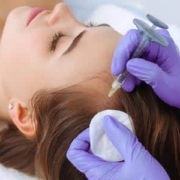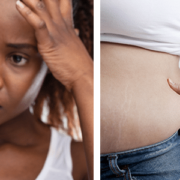How PRP Therapy Treats Female Hair Loss
Hair loss is a common problem that affects millions of women. Female hair loss is caused by a variety of factors – but genetics is the primary cause. The hormone decline of menopause, pregnancy, stress, and certain medications are also culprits behind female hair loss.
Female hair loss can be particularly distressing, as it can have a significant impact on a woman’s self-esteem and quality of life. Unfortunately, most women do not seek help for hair loss because they are ashamed, embarrassed, or mistakenly believe there is “noting they can do”.
Fortunately, there is a new, 100% natural treatment available to help address female hair loss: platelet-rich plasma (PRP) therapy. In this article Dr. Ruthie Harper, MD in Austin, TX explains how this revolutionary new hair loss treatment can restore thick, luscious, beautiful hair in women (and men!)
What is PRP therapy for hair loss?
PRP therapy is a non-surgical treatment that involves using nourishing factors from a patient’s own blood to stimulate hair growth. The procedure involves drawing a small amount of blood from the patient and placing it in a centrifuge to separate the plasma, which is rich in growth factors and platelets which nourish the scalp and lead to stem cell migration.
This platelet-rich plasma is then injected into the patient’s scalp, where it can help to stimulate the growth of new hair follicles.
How PRP Therapy Treats Female Hair Loss
PRP therapy works by delivering a concentrated dose of growth factors and platelets directly to the scalp. These growth factors and platelets help to promote the growth of new blood vessels and migration of stem cells which can in turn promote the growth of new hair follicles.
Additionally, PRP therapy can also help to reduce inflammation in the scalp, which can be a contributing factor to hair loss. By reducing inflammation, PRP therapy can create a more favorable environment for hair growth.
Benefits of PRP Therapy for Female Hair Loss
There are several benefits of PRP therapy for female hair loss. One of the most significant benefits is that it is a non-surgical treatment option. Unlike hair transplant surgery, PRP therapy does not involve any incisions or sutures, which means that there is minimal risk of scarring or infection. Additionally, because the treatment uses the patient’s own blood, there is no risk of an allergic reaction or rejection.
Another benefit of PRP therapy is that it can be used to treat a variety of types of hair loss, including androgenetic alopecia, telogen effluvium, and alopecia areata. This means that PRP therapy can be a versatile treatment option for women with different types of hair loss.
Finally, PRP therapy is a relatively quick and simple procedure that can be completed in the physician’s office in just an hour. Most patients are able to return to their normal activities immediately after the treatment, although they may need to avoid strenuous exercise for a few days.
What can patients expect during PRP therapy?
Before undergoing PRP therapy, patients will undergo a thorough medical evaluation by Dr. Ruthie Harper, MD to determine the underlying cause of their hair loss. This evaluation may include a physical exam and blood tests. This is an important part of the treatment protocol so that each individuals cause for hair loss can be determined and resolved.
On the day of the procedure, the patient’s scalp will be numbed with a local anesthetic making the procedure painless. The PRP solution will then be injected into the scalp and the entire procedure typically takes less than an hour to complete.
After the procedure, patients may experience some mild tenderness at the injection sites, but these symptoms typically resolve within a few days. Patients will typically need to undergo four sessions of PRP hair loss therapy, spaced 1 month apart, to achieve optimal results.
No Side Effects with PRP Therapy for Female Hair Loss
PRP carries minimal risks and side effects when the procedure is performed by a qualified and experienced practitioner like Dr. Ruthie Harper, MD in Austin, TX.
There are only minor side effects, including mild discomfort or swelling at the injection sites following the procedure. However, these symptoms typically resolve within a few days, and can be managed with over-the-counter pain relievers.
PRP Therapy for Female Hair Loss | Austin, TX
Platelet-rich plasma (PRP) therapy is an effective treatment option for female hair loss, available at Ruthie Harper, MD in Austin, TX. It is safe and versatile and can be used to treat a variety of types of female hair loss.
PRP therapy for hair female loss offers several benefits over other treatment options, including a quick and simple procedure, minimal risk of infection, and no risk of allergic reaction or rejection. If you are a woman in the Austin, TX area who is struggling with hair loss, schedule PRP therapy with Dr. Ruthie Harper, MD and restore your confidence and quality of life!



